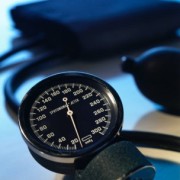High blood pressure and elevated cholesterol were among the first known risk factors for cardiovascular disease. When you have your cholesterol checked it is reported in at least 4 categories:
Triglycerides: Goal <200
Total Cholesterol: Goal <200
LDL (bad cholesterol): Goal <120 [<70>
HDL (good cholesterol): Goal >60
Triglycerides
Triglycerides are often elevated by diets high in simple sugars (cakes, cookies, and candies) as well as simple carbohydrates (breads, pastas, cereals). It is also often elevated in those with low thyroid levels. Triglycerides are lowered by avoiding simple sugars and simple carbohydrates. Fish has also been found to lower triglycerides and that is why fish oil (omega 3) is often recommended as a supplement.
LDL
Bad cholesterol is often elevated by diets high in saturated fat (animal fat) and trans fats. Saturated fats are found in animal fats and diary fat. Trans fats are found in 4% of animal fats, up to 15% of margarines fats, 30% of shortening fats, and 45% in artificially hydrogenated fats. There has been a huge push by the public interest groups to decrease the production of oils with artificial trans fats because of their significant risks. The FDA has also required companies to label the content of trans fats. That is why you have noticed a change in the taste of KFC, McDonald’s French fries, and Oreos.

HDL
This is actually a protective type of cholesterol and the higher it is the better. It is lowered by a poor diet as explained above. The biggest factor found to raise HDL is regular exercise.
The Mediterranean Diet has been described as the best diet to lower cholesterol. This diet is composed of fresh vegetables, no processed or fried foods, fish (not much meat), and olive oil. Unfortunately, diet alone is not the only factor that can cause high cholesterol as genetics can often play a significant role.
There are a few categories of medications that can lower cholesterol but most of them have not been proven to decrease mortality. Statins are one of the few medications that have been proven to do this. It is believed that statins may protect the heart by some other mechanism than lowering cholesterol. Some have suggested that it may stabilize plaques so they are less likely to break off and cause a heart attack or stroke. In fact, going off a statin can be risky as it may cause plaques to become unstable. Unfortunately, statins are not without their risks or side effects.
If you want to avoid a prescription medication, the following supplements have been proven to be effective: fish oil, niacin, and red yeast rice. In fact, red yeast rice functions almost exactly like a statin. All of these supplements have their own risks and side effects as well and so you should discuss with your doctor which medication would benefit you most. Different supplements and medications will target different cholesterol categories and so your cholesterol profile may determine which medications would work best for you.







